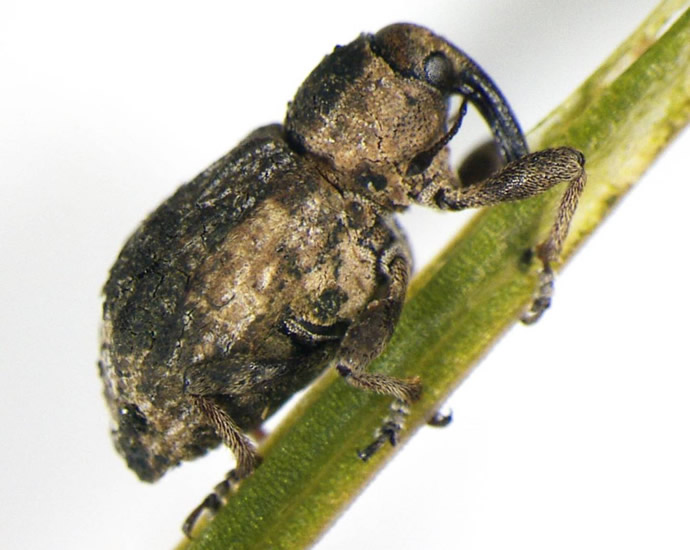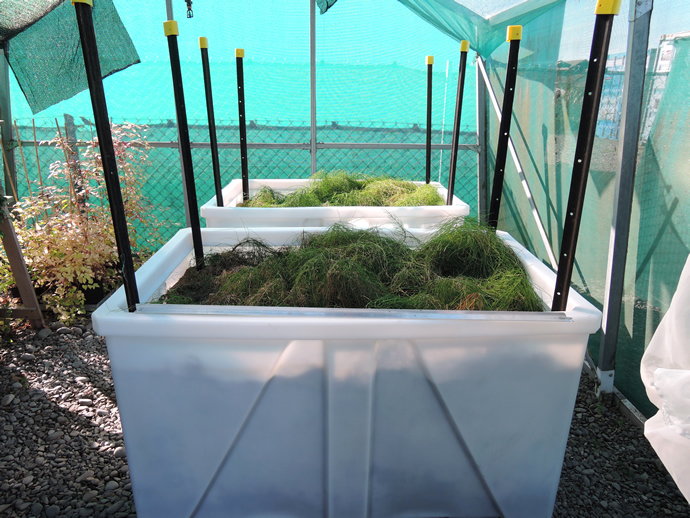Clearing a hurdle for field horsetail weevils

Adult weevil
Despite attempts at management using chemical control, its spread continues with its invasion of the Wanganui River described as “phenomenal and unstoppable” by Craig Davey from Horizons Regional Council. Craig, together with AgResearch, has tested various herbicides for field horsetail, but the plant’s persistent underground root system makes high dosages and repeat applications necessary. According to Alistair Robertson, chair of the Rangitikei Horsetail Group, field horsetail can root down to 2 metres in river silts and sands, and it is extremely difficult to get herbicides to penetrate that deep.
With the demand for a more effective and sustainable solution for field horsetail management, biocontrol options were investigated. The field horsetail weevil (Grypus equiseti) was first imported into containment for host specificity testing in 2013, and permission for its release was granted by the Environmental Protection Authority (EPA) in mid-2016. This weevil has not been used as a biocontrol agent anywhere else in the world, and it was hoped it would be the only agent needed to suppress the growth and spread of field horsetail, but the project has had some challenges. The weevil colony was initiated with a fairly small number of adult weevils received in multiple shipments from the United Kingdom. The weevils were difficult to locate in their native range, so some shipments consisted of only a few individuals, which yielded few offspring, attributed to tapering fecundity of aging females. From the low numbers of progeny produced by the imported weevils only small numbers of weevils have been mass-reared for release.

Field horsetail weevil rearing containers
As a result, only 545 weevils have been released since 2017 and establishment has yet to be confirmed. “To date, no weevils have been recovered from the field, and this year’s visits to the release sites were prevented by the Covid-19 lockdown restrictions,” said Paul Peterson, who is managing the project. “More releases of the weevil are planned, but after another disappointing rearing season, with low numbers of adults produced in 2019, we realised we needed a change in rearing tactic to boost colony numbers. When first reared in the laboratory, 10 L potted plants produced enough weevils for host range testing, but using this same method for mass-rearing in outdoor greenhouses has not produced enough adults to make large releases. This could substantially hamper the chances of successful establishment”, explained Paul.
As a start, the team have focused on improving the quantity and quality of field horsetail stem and root/rhizome material for larval feeding. Under natural conditions field horsetail stems grow up to 80 cm tall and 3–5 mm thick, with roots and rhizomes extending up to 2 m underground in ideal conditions. To try to closely mimic the stature and form of these field horsetail plants, the 10 L pots have been upsized to 20 L, 70 L and even two 1,000 L containers for cultivating stock plants for rearing the weevil. “Early indications suggest that pot size does matter, and that the visibly larger stems and root systems are providing enough food for a higher proportion of larvae to complete their development,” said Arnaud Cartier, who is rearing the weevils. “Our next hope is that we can successfully overwinter high numbers of larvae and pupae to make large releases of adult weevils this coming spring,” he added.
This project is funded by the Sustainable Farming Fund, which is administered by the Ministry for Primary Industries.